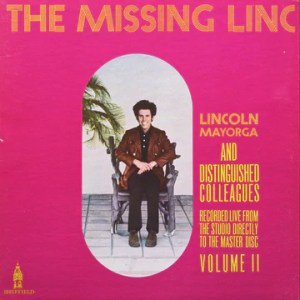More Lincoln Mayorga
More Direct-to-Disc Recordings

- This Sheffield Direct to Disc recording has INCREDIBLE Shootout Winning Triple Plus (A+++) sound or close to it throughout – exceptionally quiet vinyl too
- Guaranteed to be dramatically richer, fuller and more Tubey Magical than any other copy you have heard, with especially punchy drums and rosiny-textured strings
- The bass on side one extends all the way into WHOMP land for that big bass drum at the end of “Limehouse Blues” – what a sound!
- The top end is also key to the better pressings – lots of string harmonics and bells and other high frequency stuff gets lost on most copies, but not this one, it’s all here
- The Audiophile “Sgt. Pepper” of its day, a record that was so much better than anything else you’d ever heard it made you rethink the possibilities (and they did the same thing with Volume III two years later)
- If you’re a Sheffield Labs fan, and what audiophile wouldn’t be?, this title from 1972 is clearly one of their best
This is definitely not your typical Sheffield pressing. Some of them are aggressive, many of them are dull and lack the spark of live music, some of them have wonky bass or are lacking in the lowest octave — they are prey to every fault that befalls other pressings.
Which shouldn’t be too surprising. Records are records. Pressing variations exist for every album ever made. If you haven’t noticed that yet, start playing multiple copies of the same album while listening carefully and critically.
If your stereo is any good at all, it should not take you long to notice how different one record sounds from another.
Just listen to the texture on the saxophone on “Limehouse Blues” — you can really hear the leading edge transients of the brass that are so important to the sound of those instruments. Track after track, the sound gets surprisingly more open and airy. The harpsichord has such great presence it jumps out of the speakers. Side Two had the best bass ever — extending all the way into WHOMP land.
I was selling audio equipment (Audio Research, Fulton speakers) back in the ’70s and this was a favorite demo disc in our store. The bass drum at the end of track two would shake the foundation with a big speaker like the Fulton J.
Every bit as amazing to me was the string quartet on side 2. You could actually hear the musicians breathing and turning the pages on their music stands, just as if you were actually in their “living presence.”
This is one of the albums that made me realize how good audio in the home could really be. In a way this was the Audiophile “Sgt. Pepper” of its day, a record that was so much better than anything else you’d ever heard it made you rethink the possibilities.
This vintage Sheffield pressing has the kind of Tubey Magical Midrange that modern records can barely BEGIN to reproduce. Folks, that sound is gone and it sure isn’t showing signs of coming back. If you love hearing INTO a recording, actually being able to “see” the performers, and feeling as if you are sitting in the studio with the band, this is the record for you. It’s what vintage all analog recordings are known for — this sound.
If you exclusively play modern repressings of vintage recordings, I can say without fear of contradiction that you have never heard this kind of sound on vinyl. Old records have it — not often, and certainly not always — but maybe one out of a hundred new records do, and those are some pretty long odds.
What The Best Sides Of The Missing Linc (Volume II) Have To Offer Is Not Hard To Hear
- The biggest, most immediate staging in the largest acoustic space
- The most Tubey Magic, without which you have almost nothing. CDs give you clean and clear. Only the best vintage vinyl pressings offer the kind of Tubey Magic that was on the tapes in 1972
- Tight, note-like, rich, full-bodied bass, with the correct amount of weight down low
- Natural tonality in the midrange — with all the instruments having the correct timbre
- Transparency and resolution, critical to hearing into the three-dimensional studio space
No doubt there’s more but we hope that should do for now. Playing the record is the only way to hear all of the qualities we discuss above, and playing the best pressings against a pile of other copies under rigorously controlled conditions is the only way to find a pressing that sounds as good as this one does.
What We’re Listening For On The Missing Linc (Volume II)
- Energy for starters. What could be more important than the life of the music?
- Then: presence and immediacy. The vocals aren’t “back there” somewhere, lost in the mix. They’re front and center where any recording engineer worth his salt would put them.
- The Big Sound comes next — wall to wall, lots of depth, huge space, three-dimensionality, all that sort of thing.
- Then transient information — fast, clear, sharp attacks, not the smear and thickness so common to these LPs.
- Tight punchy bass — which ties in with good transient information, also the issue of frequency extension further down.
- Next: transparency — the quality that allows you to hear deep into the soundfield, showing you the space and air around all the instruments.
- Extend the top and bottom and voila, you have The Real Thing — an honest to goodness Hot Stamper.
TRACK LISTING
Side One
Chopin: Prelude In C Major (Opus 28)
Limehouse Blues
I Never Loved A Woman The Way I Love You
Both Sides Now
Chopin: Prelude In E Major (Opus 28)
Brasil’ 57
The April Fools
Side Two
Norwegian Wood
We’ve Only Just Begun
Peace Train
If
Blackbird
Love Rach